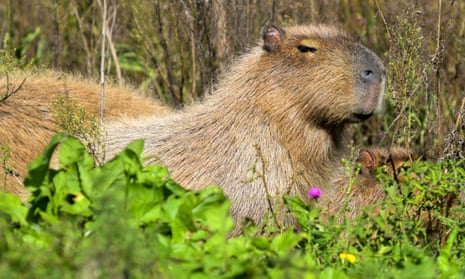Nordelta is Argentina’s most well-known gated community: an enclave of spacious homes for the rich amid a dreamy landscape of lakes and streams north of Buenos Aires.
But environmentalists question its very existence because it is built on the wetlands of the Paraná, the second most important river in South America after the Amazon.
Now, however, nature is fighting back against Nordelta’s well-heeled residents.
In recent weeks, the community has been invaded by capybaras, who have destroyed manicured lawns, bitten dogs and caused traffic accidents.
“They not only destroy gardens but their excrement has also become a problem,” one local man told the daily La Nación, complaining that local wildlife officials had prohibited residents from touching the large rodents.
Nunca pensé que iba a estar vivo para ver a los carpinchos domando chetos y librando la madre de todas las batallas en Nordelta.
— 𝔸𝕝𝕞𝕚𝕣𝕒𝕟𝕥𝕖 ℙ𝕠𝕣𝕥𝕘𝕒𝕤. 𝔻 🇫🇷🥂 (@DaniloZurita8) August 18, 2021
Estoy así: pic.twitter.com/Gy6t7viQUS
Some Nordelta residents are reported to have responded by bringing out their hunting rifles, but many other Argentinians have taken to social media to defend the rodents – known locally as carpinchos.
In politically polarized Argentina, progressive Peronists see Nordelta as the enclave of an upper class eager to exclude common people – and with tongue only partly in cheek, some have portrayed the capybaras as a rodent vanguard of the class struggle.
“My total support for the Peronist carpinchos of Nordelta recovering
their habitat,” tweeted one internet wag.
Adult capybaras can grow up to one metre (3.2ft) in length, stand over 60cm (24in) tall and can weigh up to 60 kilos (132lb). They are naturally gregarious and live in groups of between 10 and 20 individuals.
Prominent ecologist Enrique Viale said it was a mistake to frame the rodent influx as an invasion. “It’s the other way round: Nordelta invaded the ecosystem of the carpinchos,” said Viale, who has been campaigning with many others for 10 years now for congress to pass a law to defend the wetlands from development.
“Wealthy real-estate developers with government backing have to destroy nature in order to sell clients the dream of living in the wild – because the people who buy those homes want nature, but without the mosquitoes, snakes or carpinchos,” he said.
These vast Paraná wetlands stretch from northern Argentina to the River Plate and the Atlantic Ocean, but have come under attack from urban sprawl as well as cattle and soy mega-farmers who are partly responsible for the wildfires that have destroyed vast areas.
“Nordelta is the supersized paradigm of gated communities built on wetlands. The first thing it does is take away the absorbent function of the land, so when there are extreme weather events, it is the poorer surrounding neighborhoods that end up flooded. As always, it is the poor who end paying the price.”
